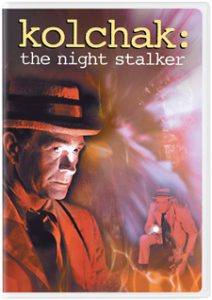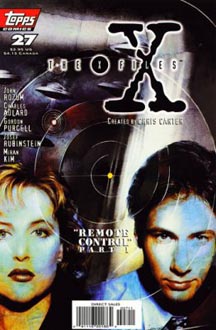In 1997, “The X-Files” was at the height of its popularity, and excitement among the Topps “X-Files” Comics creators and fans is evidenced in the letters pages, which feature tidbits about awards, ratings and other accolades. With John Rozum’s stories, though, there’s a sense of playing it safe, as the series had long since decided to let Chris Carter’s show take the lead while the comics provided supplemental adventures. In 1997, the end of Season 4 and the start of Season 5 featured Scully’s cancer and Mulder’s supposed suicide, but the comics mainly featured standalone monster-of-the-week (or -month, as it were) adventures.
There are two notable exceptions, though, where Rozum (who, starting with Issue 30, is accompanied by the new – and just as competent as their predecessors — penciling/inking team of Alex Saviuk and Rick Magyar) pushes the envelope. “Remote Control” (Issues 27-29) is a sweeping mythology three-parter about remote viewers who formerly worked for the US government and are now privately employed. One of them works for Libyan terrorists, who are using his skills to hijack a US military truck, which may or may not contain a flying saucer. For whatever reason, the comic series to this point hadn’t made use of Deep Throat (who, granted, was killed off before the comics launched), Mr. X or Marita Covarrubius. Oddly, Mulder occasionally receives information from shadowy sources that neither he nor the reader knows – a dark-haired woman and a young black man were these sources on two previous occasions.
In “Remote Control,” the comics step up their game by having Mulder consult with his one higher-up ally from the TV show, Senator Matheson. The senator is portrayed in shadows, but the letters column later confirms that this is Matheson. Unique to the comic, Matheson has an underling named Crockett who is sort of a good-guy equivalent of Krycek; he helps Mulder out of a jam, but won’t allow him to see the alien craft, because then – as the cliché goes – he’d have to kill him. Crockett also has access to a utility belt based on alien technology that can make him invisible or project a bulletproof force field. In a tasty bit of accidental continuity, the recent “X-Files” TV miniseries showed that alien crafts can become invisible.
The other meaty story from this batch is “N.D.E.” (35-36), which features a personal connection for Scully. The opening black-and-white panels show a flashback to the night before her meeting with Blevins (in 1992, the caption says, but didn’t she meet Mulder and join the X-Files team in ’93?). She’s at a bar with her friends from the academy – who reference the fact that she dated Jack Willis, a tie-in to Season 1’s “Lazarus” — one of whom is going on an undercover mission. Fast-forward to present day and Mulder and Scully are investigating an X-File associated with the mob boss who had killed Scully’s friend. “N.D.E.” also nicely incorporates Scully’s religious beliefs, as the mob boss believes from the visions of his near-death experience that he is doomed to hell. The reader also sees that Scully’s friend has gone to heaven – and so does the mob boss in the final panel – making this a daringly blunt statement for an “X-Files” yarn.

The other ’97 issues are somewhat formulaic: Rozum shows us a bizarre death(s), gives us a historical or legendary or scientific theory that could explain it, and then sees the story through to its end, with M&S not able to definitely close the case but with readers getting a hint as to what happened. These issues are fun reads, though, and could play as episodes of the TV series, albeit lesser entries.
“Be Prepared” (25-26) is similar to Season 3’s “Quagmire” in that Mulder surmises a supernatural answer (a Wendigo killing campers in the snowy Montana woods), but the actual answer is from the real world (a bear driven mad by a trap clamped to its leg). But the final panel shows a Wendigo, just as the final shot of “Quagmire” shows Big Blue.
This is the first of two yarns where Rozum gets almost-but-not-quite heavy-handed with an environmental message. The other is the best stand-alone issue of this batch: “Skybuster” (34), which continues the trend of strong “X-Files” stories set in Alaska. It opens with a classic image of a victim being carried off by a flock of ravens, which is either being driven mad by local atmospheric research tests or acting in defense of Mother Earth against humans. (Of course, as Homer Simpson would point out, a flock of ravens is known as a “murder,” and frankly it’s kind of surprising that Mulder doesn’t make this observation too.) The idea of Earth being a living organism upon which humans are a parasite is intriguing, even if it doesn’t hold up to scrutiny.
“Surrounded” (30-31) is a bit clunky. Rozum does a timely riff on the early ’90s events at Ruby Ridge and Waco where the US government killed citizens trying to live off the grid, and the story gains relevance again in 2016, especially as it is set in Oregon, site of the standoff between the government and protestors who believe it has too much control over Western lands. The downside of “Surrounded” is that Rozum doesn’t make it clear why this remote house is under siege by the FBI – it’s suggested that a resident scientist has published some writings that catch the feds’ attention, but it’s a bit vague. The upside is that the idea of killer dust mites is brilliant, and it plays better in comics than it could on TV. (The skinned victims presage the 1999 novel “Skin”).
“Crop Duster” (32) is about a man who sees gremlins, reminiscent of “Twilight Zone: The Movie.” And rounding out this batch, “Soma” (33) chronicles widowed Indian women who seem to spontaneously combust while their surroundings remain untouched (again, we get a parallel to a novel, in this case “Ground Zero”). Rozum gets creative with historical spiritual beliefs, as “Soma” is based on a ritual whereby a widow must burn herself alive along with her husband’s corpse so they may enjoy the afterlife together.
“The X-Files” comic might not have been quite as good as the parent show in 1997, but it certainly does not embarrass itself under the steady guidance of Rozum and the artists. The title did the yeoman’s work of tiding fans over between episodes.

